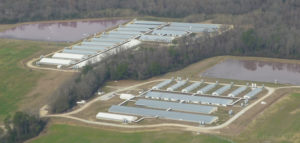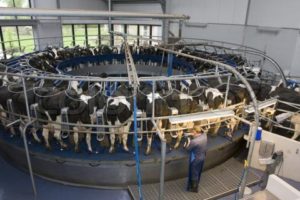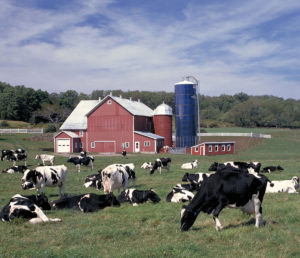John Ikerd: The Corporatization of Animal Agriculture
by johnikerd1 | February 21, 2019
We are now seeing a corporate takeover of dairy production, which is the last bastion of full-time, independent family farms in animal agriculture. Poultry was the first to come under corporate control, the second was beef, then pork, and now dairy. The corporatization of each sector has been a bit different, but all have followed the same basic pattern or process. We now see that same basic patter unfolding in dairy production.
In April 2018, Farm Aid blog proclaimed: “Since 1970, the number of American dairy farms has dropped by more than 93 percent, from more than 640,000 to around 40,000 today. In an industry dominated by corporate interests, family farms are constantly at risk of going under. A consistent, severe slump in milk prices in recent years has pushed many dairy farm businesses beyond the point of survival. In the last year, there’s been a 3 percent drop in the number of dairy farms, with the future of those remaining increasingly uncertain. Each day on our farmer hotline, we hear from dairy farmers whose farms are on the brink of foreclosure.” [i] There has been little cause for hope over the year since this blog post and little hope for a significant improvement in prices for least a year in the future.
I am more familiar with the corporate takeover of the pork industry than for poultry or beef. It happened during the 1990s, while I was still an active faculty member of the University of Missouri. Reluctantly, I became involved in the controversy surrounding corporate takeover of hog production. By then, the entire poultry industry was already vertically integrated. A few large corporations controlled all phases of production from breeding stock to retail-ready poultry products. Cattle feeding had moved from small on-farm feedlots into large corporate feedlots holding tens of thousands of animals. The remaining small feedlots where farmers and ranchers fed out their own calves were few. The longer production process for beef made it more difficult for corporations control the cow-calf and stocker phases of production, but they keep trying.
 The production process for pork was longer than for poultry but short enough to allow corporate control of the entire process—from breeding stock to finished product. Vertical integration of the pork industry had been limited by persistence disease problems in the larger confinement hog feeding operations. However, when routine feeding of antibiotics became a common practice, a major obstacle to a corporate takeover of pork production was removed. The remaining corporate challenge was to displace independent hog farmers, many of whom were very efficient producers.
The production process for pork was longer than for poultry but short enough to allow corporate control of the entire process—from breeding stock to finished product. Vertical integration of the pork industry had been limited by persistence disease problems in the larger confinement hog feeding operations. However, when routine feeding of antibiotics became a common practice, a major obstacle to a corporate takeover of pork production was removed. The remaining corporate challenge was to displace independent hog farmers, many of whom were very efficient producers.
During the 1990s, the University of Missouri operated a mail-in records program for Missouri farmers. Producers would mail copies of their purchases and sales records, which the university used to prepare financial statements that included their costs of production and profits. Each participant would be provided with summaries of financial results for similar producers so they could compare their performance with others—benchmarking. We had enough records for farmers who specialized in hog production to provide farmers with average production costs for the most efficient and least efficient as well the average efficiency of hog producers in the program. We also had accurate information regarding costs of production in the large corporate affiliated feeding operations that were trying to gain a foothold in the state at the time.
The mail-in records indicated that the large corporate feeding operations likely would be more efficient than the least efficient one-third to one-half of existing Missouri hog producers. However, the corporate operations were likely to be less efficient than the most efficient one-third to one-half of existing hog producers. In other words, any cost of production advantage for the large corporate operations would be small in comparison with the average Missouri hog producer. However, by being vertically integrated in pork processing and distribution as well as hog production, the large corporate operations were ultimately able to drive even the most efficient independent hog producers out of business.
Under political pressure from the pork industry, Missouri’s anti-corporate farming law was changed to allow a large corporate pork operation to locate in north Missouri. During the mid-90s, Premium Standard Farms built a large slaughter plant and feed mill and quickly acquired 80,000 sows expecting to produce more than 1.5 million slaughter hogs a year. Similar large corporate operations had begun earlier in North Carolina and were expanding rapidly during times of profitable hog prices. Most of the corporate hogs in North Carolina were produced under comprehensive contacts that gave the corporate virtually complete control over production. It was obvious this rapid expansion in hog numbers eventually would depress hog prices to unprofitable levels for most existing producers.
 The key to the corporate takeover was that they could easily outlast the least efficient one-third of independent producers during the inevitable depression in hog prices resulting from their expansion in production. But, the corporate operations didn’t even need to be more efficient than the average independent producer. The corporations were involved in pork processing and slaughter as well as production. The packers lowered wholesale pork prices enough to allow the pork from hogs under their control to clear the market, but only enough to leave prices seriously depressed in markets where independent producers were forced to sell. Any corporate losses on their owned or contract hogs were largely offset by wider margins of profit for hogs purchased from independent producers. Independent producers were not only forced to sell at large losses, some couldn’t find markets at any price. During the late 1990s, market prices for hogs dropped to a low of $8 per cwt. while average costs of production were more than $40 per cwt.
The key to the corporate takeover was that they could easily outlast the least efficient one-third of independent producers during the inevitable depression in hog prices resulting from their expansion in production. But, the corporate operations didn’t even need to be more efficient than the average independent producer. The corporations were involved in pork processing and slaughter as well as production. The packers lowered wholesale pork prices enough to allow the pork from hogs under their control to clear the market, but only enough to leave prices seriously depressed in markets where independent producers were forced to sell. Any corporate losses on their owned or contract hogs were largely offset by wider margins of profit for hogs purchased from independent producers. Independent producers were not only forced to sell at large losses, some couldn’t find markets at any price. During the late 1990s, market prices for hogs dropped to a low of $8 per cwt. while average costs of production were more than $40 per cwt.
Enough independent producers were eventually forced out of business to allow hog prices to return to more reasonable levels. However, as the less efficient producers were forced out of business, or became corporate contract producers to survive, an increasing share of total hog production came under corporate control. Eventually, even the most efficient independent producers couldn’t survive these market conditions. Even the vertically integrated corporations lost money at times during the takeover, and some were forced out of business as they competed for market share and control. The surviving corporations succeeded in taking over virtually complete control of the hog industry—from hog genetics to finished pork products.
The takeover process for pork was similar in many respects to earlier experiences with poultry and beef. The least efficient independent producers are the first to be forced out of business by more efficient corporate producers. Once the corporations gain control of a significant share of the total market, they can began to manipulate market prices available to remaining independent producers. During times of surplus, the corporations limit reductions in wholesale prices in order to depress and hold market prices for independent producers to unprofitable levels long enough to force the survivors out of business. Obviously, agri-food corporations would not be able to manipulate prices or marketing margins in this ways with economically competitive markets. However, corporate antitrust laws have not been seriously enforced in the U.S. since the early 1900s.
 Unfortunately, this is the harsh reality now confronting smaller independent dairy producers. The unbridled expansion of large confinement dairy operations have increased total production and depressed milk prices to unprofitable levels for most independent producers. Weaker consumer demand for dairy products has magnified the depression. The least efficient independent producers have already been forced out of business by previous expansion in production and the large corporate dairy operations are continuing to expand. The remaining independent dairy farmers are now at risk.
Unfortunately, this is the harsh reality now confronting smaller independent dairy producers. The unbridled expansion of large confinement dairy operations have increased total production and depressed milk prices to unprofitable levels for most independent producers. Weaker consumer demand for dairy products has magnified the depression. The least efficient independent producers have already been forced out of business by previous expansion in production and the large corporate dairy operations are continuing to expand. The remaining independent dairy farmers are now at risk.
The government has long been involved in pricing of milk, which makes the milk market somewhat different than for other animal products. In addition, cooperatives are among the largest corporate processors of milk but are acting more like corporations than cooperatives. It remains to be seen whether the large corporate dairy operations have gained sufficient market power to drive out the most efficient independent dairy producers. Regardless, the remaining independent dairy farmers can’t afford to ignore the lessons learned from the corporatization of poultry, beef, and pork.
John Ikerd
